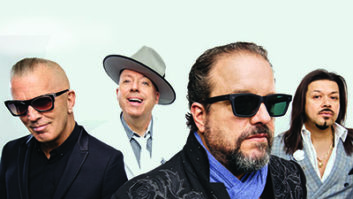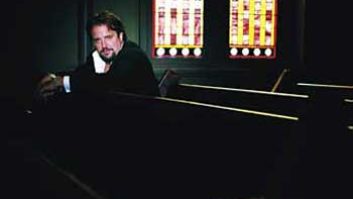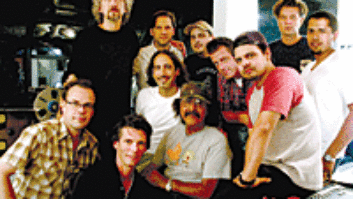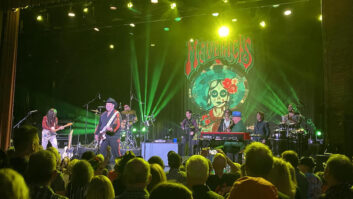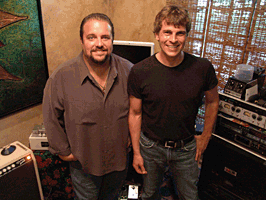

In the woods south of Nashville is bassist Jay Weaver’s personal studio, Chicken Hill. The facility was designed and installed by its owner in a 1,200-square-foot garage on his 68-acre property, reachable only via a long gravel lane. But if you’d turned down that lane a few months ago and found yourself at Chicken Hill, you’d have heard a familiar voice crooning in the woods. Weaver — who has played on sessions with many of Nashville’s finest, including a long stint with Dolly Parton — is now bassist for former Mavericks frontman Raul Malo, and Malo’s latest solo effort, After Hours, was recorded live in Chicken Hill.
“When I started playing with Raul, I wanted to have a rehearsal in my studio so I could ‘spy’ on the rehearsal,” Weaver says. “I set mics up all around and captured us playing in one room. The piano wasn’t even tuned, and I didn’t even tell them I was recording, For monitoring purposes, for Raul’s vocal I have a couple of speakers on the wall in the main room, and I ran his vocal through them with the ‘verb sound that he wanted, and we played in the main room together. We then went into the control room, and I said, ‘Hey, Raul, listen to this.’ He said, ‘I love it,’ so we used that same basic setup when we recorded the record.”
Recording artist Raul Malo (left) and bassist/studio owner Jay Weaver in Weaver’s Chicken Hill Studio, where Malo’s latest solo album, After Hours, was recorded.
Weaver’s studio comprises a large main room, control room and three iso booths, but rather than use the division of space to separate the musicians, Weaver tailored degrees of bleed between the rooms to suit the songs.
“In lieu of using headphones, we had Raul’s vocal coming through those speakers, and I had a mixer in the main room to balance the sound,” Weaver explains. “The horn player was in an iso room, and so was the upright piano and Raul’s guitar amp. I had the upright bass, the drum set and Raul singing in the main room, and I would balance how far open all of the doors were, and then manipulate the mix that was coming through the speakers until I heard the mix and fidelity I wanted, and I let that sound bleed into all the mics. So the performances you hear on there, that’s what you get. That’s Raul singing with the band in the room live.”
Weaver served as musician and co-producer on After Hours, and enlisted the help of an outside engineer, Evan Yorke, to capture the sessions to Nuendo. The studio contains a variety of newer Universal Audio mic pre’s, vintage Ampex and Telefunken pieces, and a good mic collection. However, Malo recently visited Tracy Korby’s Nashville base to talk mics and came away with enough models to cover the project.
“I happened to read about Korby online and found out there’s someone who’s making new 47s and 251s and C-12s,” Malo says, “and he’s got this convertible system you can change the heads on, and I was fascinated by this. I went over there and saw him, and it turned out he was a fan; he’d seen me play in Pittsburgh. I talked to him about what we were doing, and he was excited. He supplied us with his BLUE mic, which is a 47-like reproduction. We used a couple of FET mics on the piano and a couple on the drums; we also used a couple of 251s. It was pretty much an all-Korby session, though I think on the acoustic guitar I played, it may have been an old Neumann small-diaphragm mic that Jay had.”

The album was also mixed by Yorke and Malo at Chicken Hill. It’s a covers collection — all vintage country songs arranged in new ways. Even at the height of The Mavericks’ popularity, Malo’s interest in Latin jazz and pop music always found their way onto the band’s “country” records. This album also works in swing and jump blues, while celebrating what Malo calls “the elegant side of country music.” A version of Buck Owens’ “Crying Time,” for example, features piano stylings that are much more Bradley’s Barn than Bakersfield. And with the addition of a horn section and an uptempo beat, Hank Williams’ “Cold, Cold Heart” channels Louie Prima.
For Malo’s part, Chicken Hill was the perfect location for this project. “It’s a dream place,” he says. “It’s cozy and it’s got all the vibe in the world. You can pretty much make a record anywhere these days, but when you have a place like that, that’s off the beaten path and you’re not on the clock, you can really take your time. I realize after making records for major labels all these years we really didn’t have time to experiment. You do two songs before lunch, do two more and call it a day. This time around, we wanted to make sure we had plenty of time to try stuff, and we enjoyed every minute of it.”

READ:
The extended article!
